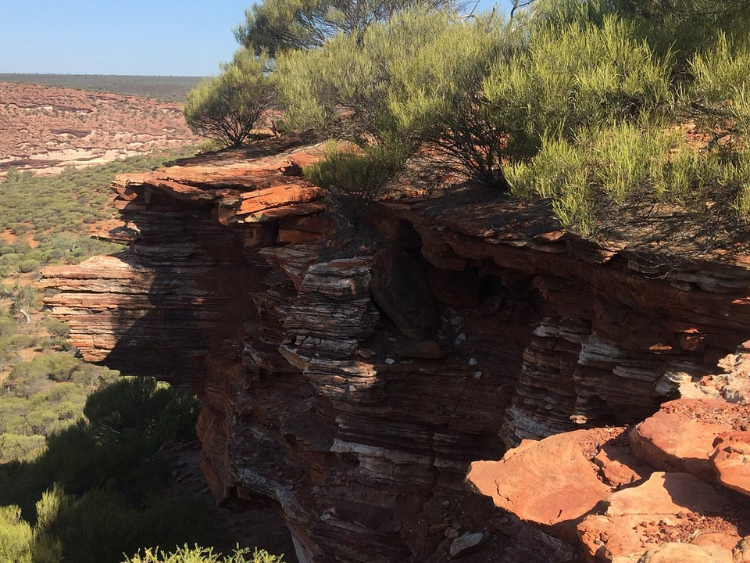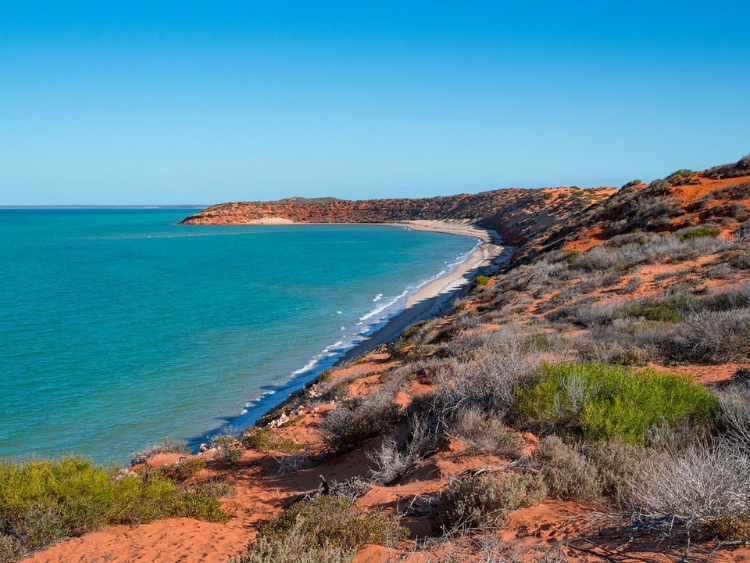
Francois Peron National Park covers an area of approximately 52,500 hectares (129,600 acres) and is characterized by its rugged landscapes, pristine beaches, and rich biodiversity. It's named after Francois Peron, a French naturalist who explored the area in the early 1800s.
The park is renowned for its unique flora and fauna, including several species of rare and endemic plants. It's also home to a variety of animals, such as emus, kangaroos, echidnas, and reptiles.
Visitors to Francois Peron National Park can enjoy a range of activities, including swimming, snorkeling, fishing, camping, and wildlife watching. The park is particularly popular for its scenic drives along designated tracks, offering stunning views of the coastline and surrounding landscapes.
One of the park's highlights is the spectacular Shark Bay coastline, which is known for its striking red cliffs, turquoise waters, and white sandy beaches. The area is also a hotspot for marine life, with opportunities for dolphin encounters, dugong sightings, and birdwatching.
Overall, Francois Peron National Park is a must-visit destination for nature lovers and outdoor enthusiasts seeking an immersive experience in the natural beauty of Western Australia's coastline.

Francois Peron National Park was established in 1993. It was named after Francois Peron, a French naturalist who explored the area in the early 1800s. Since its establishment, the park has become a significant conservation area and a popular destination for tourists seeking to explore the unique landscapes and biodiversity of Western Australia's Shark Bay region.
Francois Peron National Park's establishment in 1993 was a significant step in preserving the unique ecosystems of the Shark Bay area. The park's creation aimed to protect the diverse range of habitats found within it, including coastal dunes, salt marshes, and seagrass meadows, as well as the rich array of flora and fauna that call these environments home.
Since its inception, the park has been managed to balance conservation efforts with sustainable tourism, allowing visitors to experience the natural beauty of the area while minimizing the impact on its delicate ecosystems. It has also served as a research site for scientists studying the region's biodiversity and ecological processes.
The park's location within the larger Shark Bay World Heritage Area underscores its importance not only at a regional level but also on a global scale. Shark Bay was designated as a UNESCO World Heritage Site in 1991 due to its outstanding natural values, including its diverse marine life, unique stromatolites (ancient microbial structures), and important cultural heritage.
Overall, Francois Peron National Park stands as a testament to the ongoing efforts to conserve Western Australia's natural heritage and provide opportunities for people to connect with and appreciate the beauty and significance of its landscapes.

Francois Peron National Park was not "invented" in the traditional sense. Instead, it was established as a protected area by government authorities in Western Australia. The park was created to conserve the unique natural and cultural values of the Shark Bay region, including its diverse ecosystems, wildlife, and scenic landscapes.
The decision to establish Francois Peron National Park was likely made through a collaborative effort involving various stakeholders, including government agencies, conservationists, scientists, and Indigenous communities. The process would have involved assessing the ecological significance of the area, identifying key conservation objectives, and determining the appropriate management strategies to ensure the park's long-term sustainability.
While Francois Peron National Park was not "invented" by a single individual, its establishment represents a collective commitment to preserving and protecting the natural heritage of Western Australia for future generations to enjoy and appreciate.

Francois Peron National Park is named after Francois Peron, a French naturalist who played a significant role in exploring and documenting the natural history of Western Australia in the early 19th century. Peron was part of the Baudin expedition, a French scientific voyage that visited the Shark Bay area in 1801.
During the expedition, Peron conducted extensive studies of the region's flora, fauna, and Indigenous cultures. His observations and writings provided valuable insights into the biodiversity and ecological processes of Western Australia at a time when much of the continent remained unexplored by Europeans.
In recognition of his contributions to the understanding of Australia's natural heritage, the national park on the Peron Peninsula was named after Francois Peron. This serves as a tribute to his pioneering efforts in scientific exploration and his role in documenting the rich biodiversity of the Shark Bay region.




Francois Peron National Park offers an excellent hiking experience for outdoor enthusiasts for several reasons:
1. Diverse Landscapes: The park features a variety of landscapes, including coastal dunes, rugged cliffs, sandy beaches, and arid shrublands. Hiking trails traverse these diverse environments, providing hikers with the opportunity to explore different ecosystems and enjoy a range of scenic views along the way.
2. Remote Wilderness: Francois Peron National Park is relatively remote and less visited compared to other national parks in Western Australia. This remoteness adds to the sense of adventure for hikers, offering opportunities to immerse oneself in pristine wilderness and experience solitude amidst nature.
3. Scenic Coastal Trails: The park's coastal trails offer stunning views of the Shark Bay coastline, with its striking red cliffs, turquoise waters, and white sandy beaches. Hikers can enjoy walks along the shoreline, observing the interplay between land and sea and spotting marine wildlife such as dolphins and seabirds.
4. Wildlife Encounters: The park is home to a diverse array of wildlife, including kangaroos, emus, reptiles, and numerous bird species. Hiking in Francois Peron National Park provides opportunities for wildlife encounters, with the chance to observe animals in their natural habitats.
5. Cultural Heritage: The area has cultural significance to the local Indigenous people, the Malgana Aboriginal people. Hiking trails in the park may pass by sites of cultural importance, such as shell middens or ancient rock art, providing hikers with insights into the region's Aboriginal heritage.
6. Camping Opportunities: The park offers camping facilities, allowing hikers to extend their wilderness experience overnight. Camping under the stars in Francois Peron National Park provides a unique opportunity to disconnect from the modern world and fully immerse oneself in nature.
Francois Peron National Park offers hiking lovers the chance to explore a remote and diverse wilderness area, with scenic trails, abundant wildlife, and opportunities for adventure and discovery at every turn.





While Francois Peron National Park offers hiking opportunities throughout the year, the best time for hiking may depend on personal preferences and considerations such as weather, wildlife sightings, and visitor numbers.
1. **Winter (June to August):** Winter in Western Australia typically brings milder temperatures, making it an excellent time for hiking in Francois Peron National Park. The weather is generally cooler and more comfortable for outdoor activities, with daytime temperatures ranging from mild to warm. Winter also coincides with the region's wildflower season, when the landscape comes alive with colorful blooms, adding to the scenic beauty of hiking trails.
2. **Spring (September to November):** Spring is another popular time for hiking in Francois Peron National Park, as temperatures begin to warm up, and the landscape bursts into bloom with wildflowers. Springtime hikes offer the opportunity to witness the park's vibrant flora and fauna, including birdlife and migrating whales along the coastline.
3. **Autumn (March to May):** Autumn can also be a pleasant time for hiking in the park, with cooler temperatures compared to the summer months. Hikers can enjoy comfortable weather conditions and fewer crowds, making it an ideal time to explore the park's trails at a leisurely pace.
4. **Summer (December to February):** Summer in Western Australia can bring hot and dry conditions, especially during the peak of summer. While hiking is still possible in Francois Peron National Park during this time, it's essential to take precautions to avoid heat-related issues. Early morning or late afternoon hikes are recommended to avoid the hottest part of the day, and adequate hydration and sun protection are essential.
Ultimately, hiking in Francois Peron National Park can be enjoyable year-round, but it's essential to consider seasonal variations in weather and wildlife activity when planning your visit. Checking weather forecasts and park conditions beforehand can help ensure a safe and enjoyable hiking experience.